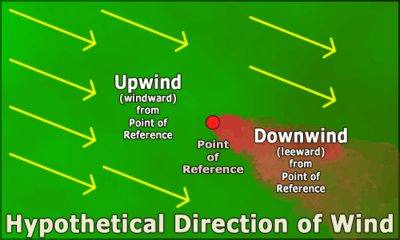Windward and leeward
Windward (/ˈwɪndwərd, ˈwɪnərd/) is the direction upwind from the point of reference, alternatively the direction from which the wind is coming. Leeward (/ˈliːwərd, ˈljuːərd/) is the direction downwind (or downward) from the point of reference. The leeward region of mountains generally remains dry as compared to the windward. The side of a ship that is towards the leeward is its lee side. If the vessel is heeling under the pressure of the wind, this will be the "lower side". During the age of sail, the term weather was used as a synonym for windward in some contexts, as in the weather gage.

Nautical and naval
Windward and leeward directions are important factors (points of sail) to consider when sailing a sailing ship. Other terms with broadly the same meaning are widely used, particularly upwind and downwind.[1]
The windward vessel is normally the more maneuverable vessel. For this reason, rule 12 of the International Regulations for Preventing Collisions at Sea, applying to sailing vessels, stipulates that where two are sailing in similar directions in relation to the wind, the windward vessel gives way to the leeward vessel.[2]
Naval warfare
In warfare, a square-rigged warship would often try to enter battle from the windward direction (or "hold the weather gage"), thus gaining an important tactical advantage over the opposing warship – the warship to windward could choose when to engage and when to withdraw. The opposing warship to leeward could often do little but comply without exposing itself unduly.[3]
This was particularly important once artillery was introduced to naval warfare. Ships heel away from the wind, so the leeward vessel was exposing more of her side to shot.[4]
Meteorological significance
Leeward and windward refer respectively to what a game stalker would call downwind and upwind.[5] The terms are used by seamen in relation to their ships but also in reference to islands in an archipelago and to the different sides of a single island. In the latter case, the windward side is that side of an island subject to the prevailing wind, and is thus the wetter side (see orographic precipitation). The leeward side is the side protected by the elevation of the island from the prevailing wind, and is typically the drier side of an island. Thus, leeward or windward siting is an important weather and climate factor on oceanic islands.[6]
In the case of an archipelago, windward islands are upwind and leeward islands are the downwind ones.
The terms upwind and downwind
In these contexts the terms windward and leeward are not used.
- Hunting: In hunting, the animal that is downwind has an advantage. It can smell the upwind animal, but the reverse is not true. The downwind animal has the advantage of surprise when hunting the upwind animal.
- Architecture and urban planning: Part of a house, or a community, is located upwind of something downwind that is malodorous — an outhouse, a garbage dump, a feedlot, a factory or meatpacker. It is sometimes the case that part of a house or a community, or sometimes the entire house or community, will be downwind of some pleasant odor. These odors are either plant-based — flowers, fruit or flowering trees, forests —, or moving water — rivers, waves, rain.
See also
- Barlavento (Windward) and Sotavento (Leeward) in Cape Verde Islands
- Downstream and upstream
- Foehn wind
- Lee shore
- Northwestern Hawaiian Islands, also known as Leeward Islands
- Windward Islands, Leeward Islands and Leeward Antilles (in the Lesser Antilles)
- Windward Islands and Leeward Islands (in the Society Islands)
References
- Patrick M. Royce (1 April 1993). Royce's Sailing Illustrated Course: Provides Lectures That Can Be Read Word for Word. ProStar Publications. pp. 11–. ISBN 978-0-911284-01-0.
- Navigators International Rules of the Road' 1998 Ed. Rex Bookstore, Inc. pp. 73–. ISBN 978-971-23-2239-6. Handling of the leeward vessel may be severely affected if she passes into the lee of the windward vessel. Handling of the windward vessel is free of such complication.
- David Childs (30 April 2014). The Warship Mary Rose: The Life and Times of King Henry VII's Flagship. Seaforth Publishing. pp. 127–. ISBN 978-1-4738-5285-3.
- Sam Willis (2008). Fighting at Sea in the Eighteenth Century: The Art of Sailing Warfare. Boydell Press. pp. 152–. ISBN 978-1-84383-367-3. Specifically, more of the critical strip "twixt wind and water" was exposed. In extreme cases even part of the bottom might be exposed.
- E. B. Michell (22 December 2015). The Art and Practice of Hawking. Read Books Limited. pp. 250–. ISBN 978-1-4733-6546-9.
- Michael Pidwirny (5 September 2016). Glossary of Terms for Physical Geography. Our Planet Earth Publishing. pp. 286–. ISBN 978-0-9877029-0-6.